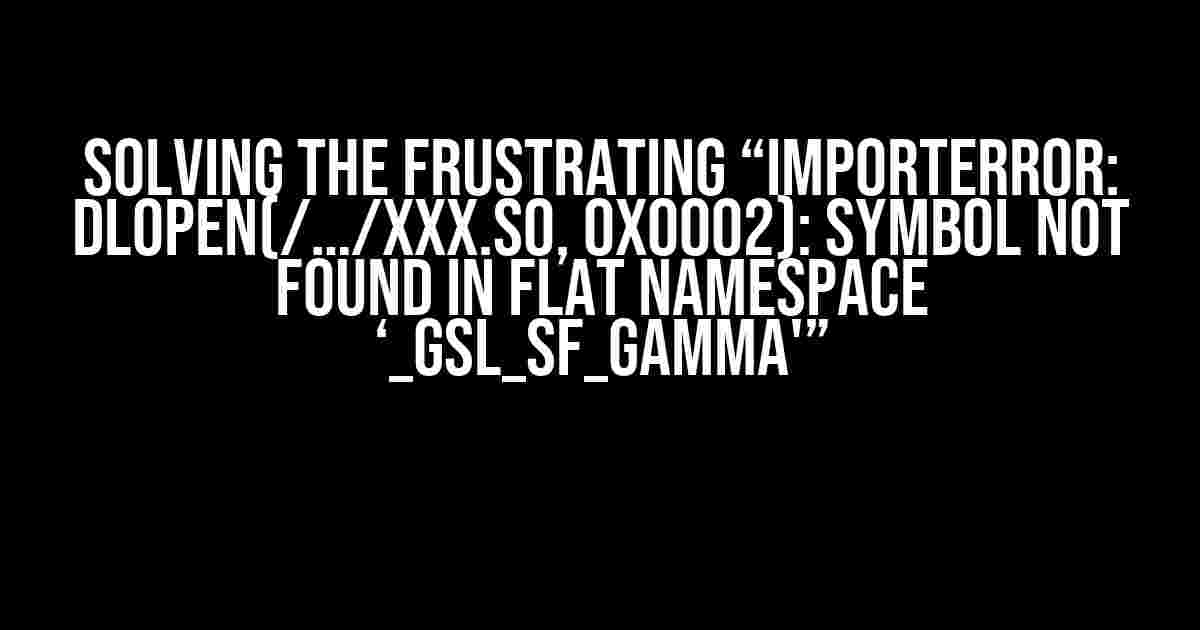Are you tired of encountering the dreaded “ImportError: dlopen(/…/XXX.so, 0x0002): symbol not found in flat namespace ‘_gsl_sf_gamma'” error? You’re not alone! This pesky issue has been driving developers crazy for years, but fear not, dear reader, for we’re about to embark on a journey to conquer this beast once and for all.
What’s Causing the Error?
Before we dive into the solution, let’s take a step back and understand what’s causing this error. The “_gsl_sf_gamma” symbol is a part of the GNU Scientific Library (GSL), a collection of numerical routines for scientific computing. The error occurs when the Python interpreter attempts to load a shared library (XXX.so) that depends on the GSL library, but can’t find the required symbol.
Why Does This Happen?
There are a few reasons why this error might occur:
- Missing or corrupted GSL installation
- Incompatible or outdated versions of GSL and Python
- Incorrectly configured library paths
- Conflicting library versions
Solving the Error: A Step-by-Step Guide
Now that we’ve diagnosed the problem, let’s get our hands dirty and fix it! Follow these steps to bid farewell to the “ImportError: dlopen(/…/XXX.so, 0x0002): symbol not found in flat namespace ‘_gsl_sf_gamma'” error:
Step 1: Verify Your GSL Installation
First, ensure you have GSL installed on your system. If you’re using a package manager like Homebrew (on macOS) or apt-get (on Linux), you can install GSL with the following commands:
brew install gsl (on macOS)
sudo apt-get install libgsl-dev (on Linux)For Windows users, you can download the GSL binaries from the official website and follow the installation instructions.
Step 2: Check Your GSL Version
Verify that you’re running a compatible version of GSL. You can do this by:
brew info gsl (on macOS)
dpkg -l libgsl-dev (on Linux)Make sure your GSL version is 2.5 or higher, as older versions might cause compatibility issues.
Step 3: Update Your Python Version (If Necessary)
If you’re using an outdated version of Python, it might not be compatible with the latest GSL version. Check your Python version with:
python --versionIf you’re running Python 3.6 or older, consider upgrading to a newer version (e.g., Python 3.9 or higher) to ensure compatibility.
Step 4: Configure Your Library Paths
Next, make sure your system’s library paths are correctly configured. You can do this by:
export LD_LIBRARY_PATH=/usr/local/lib:$LD_LIBRARY_PATH (on Linux/macOS)
set LD_LIBRARY_PATH=C:\path\to\gsl\lib;%LD_LIBRARY_PATH% (on Windows)Replace “/usr/local/lib” or “C:\path\to\gsl\lib” with the actual path to your GSL installation’s library directory.
Step 5: Reinstall / Update Your Python Package
Now that your system’s configuration is in order, reinstall or update the Python package that’s causing the error. For example, if you’re using a package like SciPy that depends on GSL, you can update it with:
pip install --force-reinstall scipyReplace “scipy” with the actual package name that’s causing the error.
Troubleshooting and Advanced Solutions
If the above steps don’t resolve the issue, don’t worry! We’ve got some advanced solutions to try:
Recompile GSL with the Correct Flags
Sometimes, GSL might need to be recompiled with specific flags to ensure compatibility. You can try recompiling GSL with:
./configure --enable-shared --enable-static
make
make installThis will rebuild GSL with shared and static library support.
Use a Virtual Environment
If you’re still encountering issues, try creating a virtual environment with a fresh installation of Python and GSL. This can help isolate the problem and ensure a clean slate:
python -m venv myenv
source myenv/bin/activateInstall GSL and your Python package within the virtual environment.
Check for Conflicting Library Versions
If you have multiple versions of GSL installed, it might cause conflicts. Use the following command to check for duplicate GSL installations:
ldconfig -p | grep gslRemove any unnecessary or outdated versions of GSL to avoid conflicts.
Conclusion
By following these steps and troubleshooting tips, you should be able to resolves the “ImportError: dlopen(/…/XXX.so, 0x0002): symbol not found in flat namespace ‘_gsl_sf_gamma'” error. Remember to stay calm, patient, and methodical in your approach. If you’re still stuck, feel free to reach out to the community or GSL developers for further assistance.
Happy coding, and may the GSL be with you!
| Troubleshooting Checklist | ✔ |
|---|---|
| Verified GSL installation | ✔ |
| Checked GSL version | ✔ |
| Updated Python version (if necessary) | ✔ |
| Configured library paths | ✔ |
| Reinstalled / updated Python package | ✔ |
| Tried advanced solutions (recompiling GSL, virtual environment, etc.) | ✔ |
✔ indicates a step you’ve completed. Make sure to tick off each item as you go through the troubleshooting process!
Frequently Asked Question
Stuck with the infamous “ImportError: dlopen(/…/XXX.so, 0x0002): symbol not found in flat namespace ‘_gsl_sf_gamma'” error? Fear not, friend, for we’ve got the solutions you’ve been searching for!
What is the main reason behind this error?
The error occurs when the GSL (GNU Scientific Library) is not properly installed or the library is not found in the system’s path. The `_gsl_sf_gamma` symbol is a part of the GSL, and the error indicates that it’s missing.
How do I check if GSL is installed on my system?
You can check if GSL is installed by running the command `gsl-config –version` in your terminal. If GSL is installed, it will display the version number. If not, you’ll get an error message.
What if I have GSL installed, but still get the error?
In this case, the issue might be that the library is not in the system’s path. You can try setting the `DYLD_LIBRARY_PATH` or `LD_LIBRARY_PATH` environment variable to point to the GSL library location.
How do I install GSL on a Linux-based system?
You can install GSL on a Linux-based system using the package manager. For example, on Ubuntu-based systems, run `sudo apt-get install libgsl-dev` to install GSL.
What if I’m using a Python package that requires GSL, and I’ve already installed GSL?
In this case, you might need to reinstall the Python package using a package manager like pip or conda, making sure that GSL is installed and in the system’s path before installing the package.
